Dancing and music have many benefits, from improving physical development to enhancing problem-solving and language skills. However, what may surprise some is the significant advantage of music and dance when it comes to improving mathematical skills, especially from a young age. This blog will explore the link between dancing, music, and maths skills.
Physical development is a crucial aspect of dancing and listening to music. Learning to dance requires skills such as balance, control, correct facial expressions, and coordination, which significantly impact the development of motor skills. Furthermore, music can also improve language skills, comprehension to form sentences, and vocabulary and communication skills. On the other hand, mathematics is a universal language that plays an essential role in understanding the world around us and job and career opportunities.
The brain’s two hemispheres process certain types and frequencies of sound in different ways. Using specific music and sounds may stimulate one hemisphere more than the other and create more balance in the brain. For instance, Einstein used to sit and play music when he was stuck on a mathematical problem. By concentrating on the problem at hand (left brain) while playing the piano or violin (right brain), he strengthened the communication between the two hemispheres of his brain and increased brainpower.
Similarly, dancing is a mix of rhythm, shapes, and patterns. Therefore, mathematics is clearly linked to both maths and dance and understanding all three. When you explain mathematics, dance can help understand abstract forms and shapes, making learning more enjoyable. Involving a child in learning beyond a worksheet is a form of learning that is lifelong.
Learning to move in geometrical patterns visually stimulates the brain to absorb information and fires up the neurons in the brain when learning mathematics. With geometry, dancing would look a lot different, and dancers could synchronize or create shapes. Counting beats, keeping time, and learning new steps require a basic understanding of mathematical concepts. Recent studies have shown that kids who participate in music and dance classes score significantly higher on maths tests than those who don’t.
In conclusion, dancing and music are excellent ways to improve maths skills from a young age. The link between dancing, music, and maths is evident, and understanding all three can enhance learning and make it more enjoyable. So, what are you waiting for? Get your dancing shoes on, and let’s start moving!


